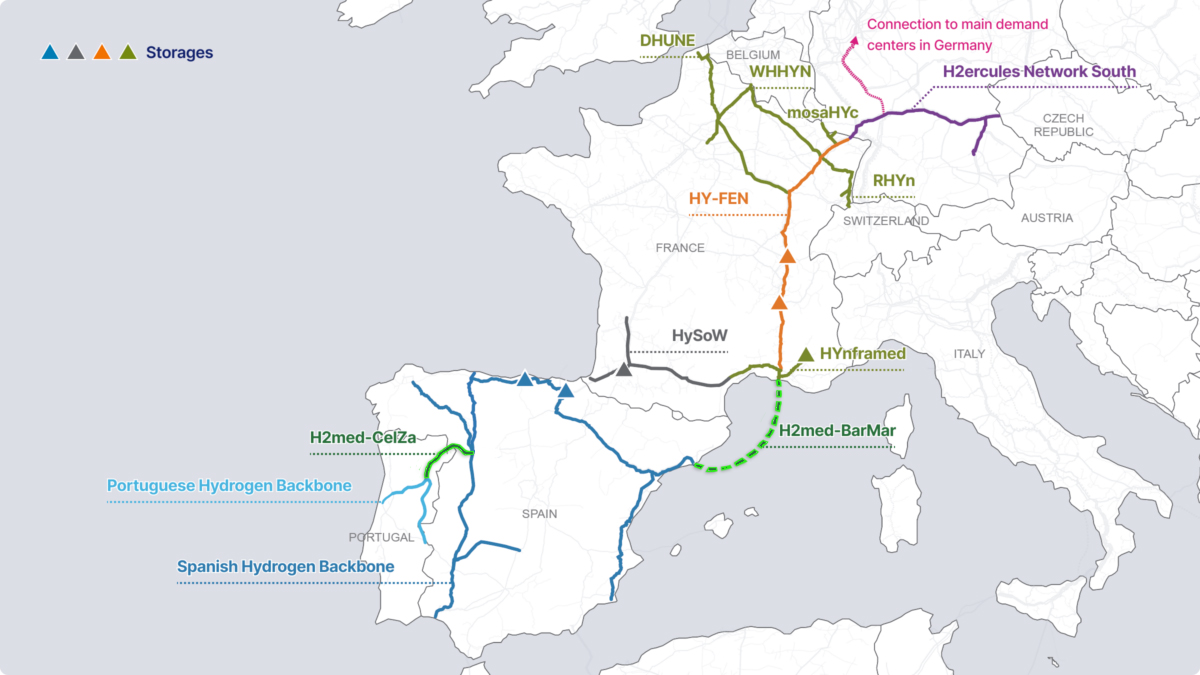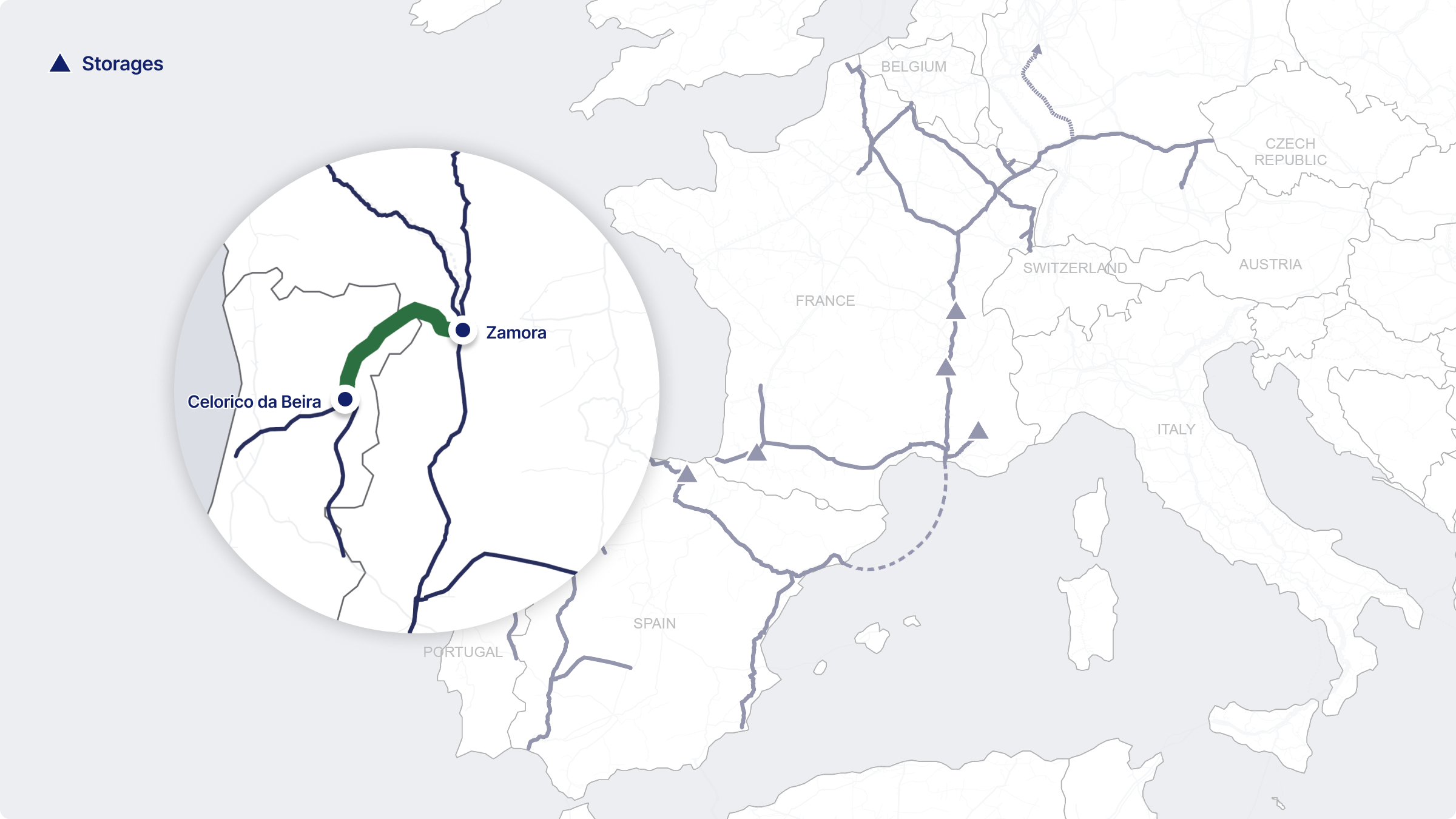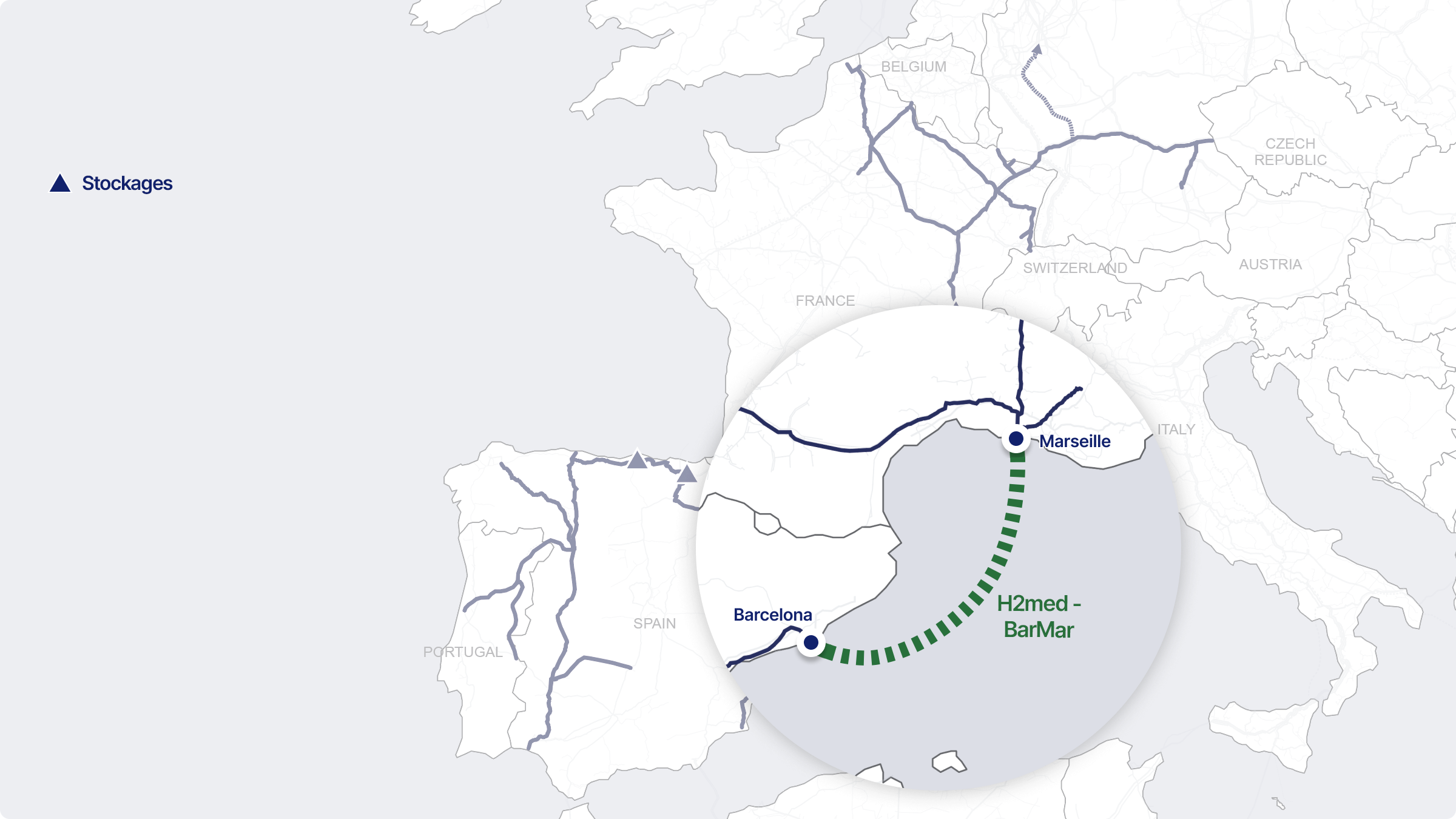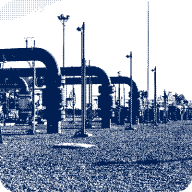
The H2med project Supplying Europe with affordable carbon-free energy
Webinar H2med – Call For Interest Results
On February 10, 2025, the H2med Consortium hosted a webinar to present the results of the Call for Interest launched last November.
Agenda
- – Key Figures from the Call for Interest: volumes, production, consumption, and regional distribution of contributions.
- – Call for Interest Results: capacity analysis and market forecasts.
- – Next Steps: project timeline, financing, and implementation.
→ Access the webinar slide desk via THIS LINK.
Why should you watch the replay?
Discover:
- The latest developments in the H2med project and its key role in Europe’s hydrogen strategy.
- The contributions and perspectives shaping the future of the hydrogen corridor across Europe and beyond.
→ Watch the replay HERE.
CALL FOR INTEREST (CFI)
Thank you for your contributions!
The Call for Interest (CFI) for the H2med corridor was launched to assess market interest in the project’s hydrogen transport capacities. The initial phase allowed registered users to complete and refine their submissions until 10th January 2025.
The CFI is now successfully closed. Data analysis is currently underway, and results will be shared as soon as they are available. Stay tuned!
To read more about the launch of the Call For Interest.
FREQUENTLY ASKED QUESTIONS
The frequently asked questions regarding the registration form for users or entities, as well as the matchmaking module (Q&A), are available in this PDF document.
The H2med project is a transnational initiative to interconnect the hydrogen networks of the Iberian Peninsula to Northwest Europe, enabling Europe to be supplied with affordable green hydrogen by 2030. This initiative was launched by France, Spain and Portugal, with a strong support by Germany, and is promoted by the TSOs of these countries: Enagás, NaTran, OGE, REN, and Teréga.
On the 20th of October 2022, alongside the Council of the European Union, the President of the Government of Spain, the President of the French Republic and the Prime Minister of Portugal decided to accelerate the development of energy interconnections and to create a green energy corridor connecting Portugal, Spain and France with the European energy network. They also agreed on the conclusion of a hydrogen interconnection between Portugal and Spain (Celorico da Beira – Zamora) as well as the development of a maritime pipeline connecting Spain and France (Barcelona – Marseille) in order to transport renewable hydrogen from the Iberian Peninsula to North and Central Europe. The three leaders ratified this commitment in the Euromed Summit on December 9th, 2022, in Alicante, with the support of the President of the European Commission Ursula von der Leyen.
Building on this political commitment, Enagás, NaTran, REN and Teréga have been cooperating since the 20th of October 2022 to provide technical advice to their respective governments related to the development of H2med. The four infrastructure operators signed a Memorandum of Understanding (MoU) to formalise their commitment to collaborate on the joint development of H2med, following the mandate of the Governments of the three countries given at the Euromed Summit. The objective of this partnership is to make the infrastructure available as of 2030. On December 15th, 2022, the four transmission system operators also jointly submitted the H2med project as candidate for the Project of Common Interest (PCI) under the new regulation on Trans-European Energy Network (TEN-E).
On January 2023, Germany has decided to lend its support and join France, Spain, Portugal for this hydrogen corridor. “We have decided to expand the H2med project which, with the support of European funding, will connect Portugal, Spain, and France to Germany, which will be a partner in this hydrogen infrastructure strategy,” declared the French President Emmanuel Macron during a joint press conference with German Chancellor Olaf Scholz, on the occasion of the 60th anniversary of the reconciliation treaty between Paris and Berlin.
On October 18th, 2023, the German TSO OGE joined the H2med project during the presentation of the corridor in Berlin. OGE’s involvement in the H2med initiative stresses the vital importance for Germany of a reliable hydrogen import corridor.
On the 8th of April 2024, the list of Projects of Common Interest (PCI) / Projects of Mutual Interest (PMI) was officially published in the Official Journal of the European Union, which includes the H2med project.
Check back this page regularly to keep updated on the latest developments.
The routes

- 648 km of pipeline length
- 2 MTPA (million tonnes per annum) of transmission capacity
- ≈ €2.50 billion overall budget
- Target commissioning: Early 2030s

- 248 km of pipeline length
- 0.75 MTPA (million tonnes per annum) of transmission capacity
- ≈ €350 million budget
- Target commissioning: Early 2030s

- 400 km of pipeline length
- 2 MTPA (million tonnes per annum) of transmission capacity
- ≈ €2,135 million budget
- Target commissioning: Early 2030s
The corridor can transport 10% of expected hydrogen consumption in Europe by 2030
CelZa: linking Portugal and Spain with green hydrogen
CelZa is a 248 km pipeline project joining Portugal and Spain, connecting Celorico da Beira (Portugal) to Zamora (Spain). It will be a bridge between the developing core hydrogen backbones of both countries. Each of the two TSOs involved, REN and Enagás, will fully own their section of the infrastructure: 162 km in Portugal, 86 km in Spain.
CelZa will be a 100% hydrogen transmission infrastructure that will be the prime export medium for hydrogen produced in Portugal from renewable energy sources, most notably solar and wind.
BarMar: linking Spain and France with green hydrogen
BarMar is a 450 km offshore hydrogen pipeline project that will join Barcelona (Spain) to the industrial hub in Fos-sur-Mer, near Marseille (France). The project will be a major connection to export hydrogen produced in Portugal and Spain from renewable sources (essentially solar and wind) at competitive costs, to the French hydrogen backbone itself connecting to the developing hydrogen infrastructure in Germany and the rest of Northwest Europe.
Technical specifications
| CelZa | BarMar | |
|---|---|---|
| Pipeline | ||
| Length | 248 km | 400 km |
| Diameter | 28″ | 42″ |
| Maximum depth | / | Up to 120 m |
| Operating pressure | up to 100 bar | Up to 100 bar |
| Compressor station | ||
| Power | 24.6 MW | Up to 60 MW |
| Maximum transmission capacity | 0.75 Mt | 2 Mt |
| Budget | ≈ €350 million | ≈ €2,135 million |
H2med potential and benefits for Europe
Energy and Environmental

Transport 10% of expected hydrogen consumption in Europe by 2030

Accelerate Europe’s decarbonization roadmap and net-zero objectives

Supply Europe with carbon-free hydrogen produced at competitive costs

Ensure the flexibility and resilience of the energy network through access to underground hydrogen storage capacities
Socio-Economic

Contribute to European and national objectives for the deployment of the hydrogen sector

Enable the development of hydrogen valleys and an high-value and cost-competitive intra-European industry

Facilitate the creation of decarbonization ecosystems and value chain development, contributing to job creation and economic growth
Project timeline

What’s on the news ?
-
03 Jul 2025
H2med Hydrog en Corridor Reaches Key Milestone with the Launch of the BarMar Company
![]()
-
24 Jun 2025
Executive Vice-President of the European Commission Teresa Ribera receives H2med Consortium CEOs to be informed of the advancement of the European hydrogen corridor
![]()
-
10 Feb 2025
Results of the Call for Interest -H2med promoters share insights and outline future steps of the project
![]()


